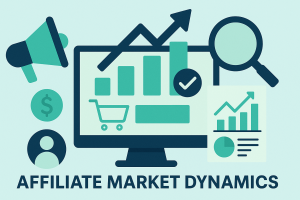
Share
Whether you’re a brand working with a marketing agency like ours or going it alone, there’s almost no way to create an omnipresent marketing strategy without focusing on the affiliate channel in a major way.
Essentially, the goal for marketers in this new decade is to put the consumer in the driver’s seat. While so often we focus on strategies that aim to merely grab the attention of the potential buyer however we can, instead, it’s now necessary to improve the shopping experience from top of funnel all the way to checkout.
But what does that mean? Well, it means focusing on deal discovery, better more seamless payment and browsing ability, and generally creating a better shopping experience.
Not to mention, money talks, and marketers are listening.
Facebook, Google and Amazon are all charging higher fees for advertising—fees to purchase access to their respective channel’s audiences—with no guarantee of results whatsoever. The game has become more difficult to play, especially for companies and brands looking to scale and sustain revenue growth.
On the other hand, investment in the affiliate space is increasing and leveling the playing field for any brand looking to improve their bottom line. The large acquisition for $4 billion of one of our partners, Honey, by PayPal was a key indication that affiliate marketing is only going to increase in popularity for brands of all shapes and sizes.
But you don’t need $4 billion to succeed in the affiliate space. You just need to be aware of these 5 simple pieces of information that most accurately reflect why marketers who choose to ignore the affiliate channel will not see optimal ROI on their advertising spend.
1. Affiliate marketing is the smart choice for companies looking to spend less on advertising while also seeing positive results
I hinted at this in the introduction, but what I’m recommending is not to create an affiliate-only strategy – although we’ve seen people who have and who’ve had success.
Rather, I think it’s important to include the affiliate channel amongst one’s arsenal of marketing methods. Other more traditional ways to ignite customer acquisition might still be effective. However, with rising costs of advertising on social channels and through other more traditional avenues makes affiliate a no-brainer to allocate at least some portion of your ad budget to.
Also, with affiliate you can access a wide array of publisher partners—including those that may have been too expensive to work with in the traditional channels. Affiliate provides reach to broad consumer audiences and has made technological advances that automate the process of finding, reaching and converting consumers.
I’d argue there’s no better investment you can make as far as ad spend than spending on an affiliate program.
2. Almost all of the world’s top brands are now leveraging affiliate, realizing there’s power in the consumer “journey”
There was once a common misconception that affiliate was a bottom-of-funnel strategy, mostly geared towards last-click publishers. Some people don’t believe in this idea of the customer journey being enhanced through affiliate, but top brands don’t fall under that category of people.
Affiliate is adopted by more than 80% of brands, with direct-to-consumer (D2C) brands particularly in tune with the opportunity and results the channel can deliver.
A major reason for this adoption among D2C brands is because affiliate marketing resides at every point of the buyer’s journey, offering brand awareness/recognition, engagement/re-engagement and conversion all the while providing consumers with the type of high-quality, informative content they crave.
So essentially, people want the best and most seamless experience possible whenever they utilize technology. Why wouldn’t that translate to e-commerce? Mobile optimization, easiest possible checkout process, ability to compare deals, excellent content strategy, and other methods affiliates use to win over customers are working. And brands are hopping on board.
3. Affiliate marketing is a cross-channel lever that works
Remember that “journey” I spoke of? Well, wouldn’t you want to find the best way to be involved with as many touch points as possible along that journey for the consumer you’re looking to target?
By working with partners who leverage various channels that correspond with the all the phases in the sales funnel including upper funnel like podcasts, influencers and various commerce content partners, marketers can identify additional points of value, streamline their campaign budgets and focus on areas that offer the highest return on as spend (ROAS).
And for the partner, they can rest easy knowing that the technology to measure their performance—no matter where they fell in the clickstream—is in place.
4. According to a recent survey, affiliate marketing provides a 12:1 ROAS (return on ad spend)
Pricewaterhousecooper (PwC) and the Performance Marketing Association (PMA) worked together to create a whitepaper in 2018 that formally valued the affiliate industry at $6.2 billion.
Of course, this was long before the aforementioned PayPal Honey acquisition. So, that number has certainly increased. However there were some other key findings from the study that are pretty important.
Some of the key takeaways from the study include:
- The highest ad spend by affiliate type went to Content and Bloggers at 39%.
- Although Return on Ad Spend (ROAS) varied greatly by advertiser sector, the average ROAS excluding financial institutions was 12:1.
- Retail accounted for 50% of total spend by sector.
5. Content still drives a large share of affiliate marketing activity
Condé Nast, Meredith, Time, BuzzFeed, Business Insider and the Daily Beast (to name just a few), are all active in the affiliate channel.
These are major publications, and again, gaining access to them through traditional channels can be incredibly expensive. That being said, they are all leaning into affiliate in a really big way.
And they’re dedicated to creating quality content that aims to help their readers or viewers—add value in some way—rather than simply acting as a generic ad for a product or service. When you consider that the average consumer visits three non-commercial sites to gather information about a product or service before purchasing it, it becomes clear how valuable the information and recommendations provided by partners truly is.
–
So, the bottom line here is that affiliate is the most likely channel to generate profitable marketing. And after all, there’s really no reason to hire a massive traditional advertising agency that can cost thousands per month, when you might just be bleeding money by working with them.
Of course, we aren’t the only affiliate managers in town. There are many others who do a great job. However, we do have a great success rate. We encourage you to do your homework and reach out if you think we’re a good match for all of your affiliate-related needs.



